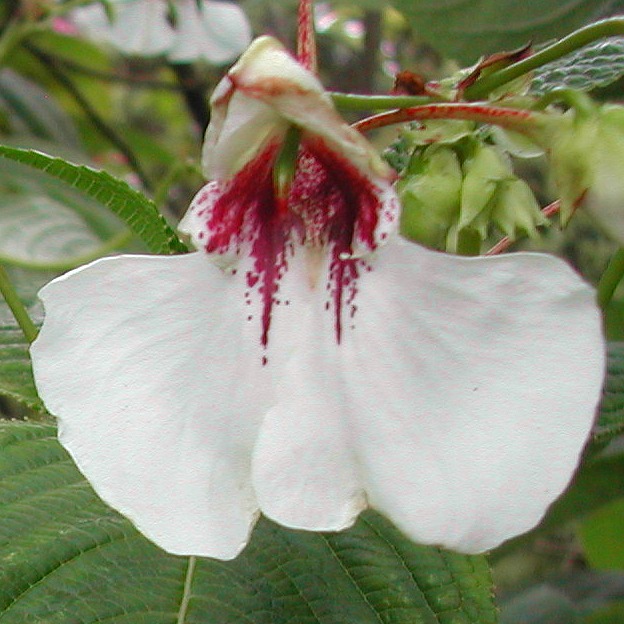| Home |
Strange Wonderful Things
Rare and exotic plants
|
 |
Impatiens tinctoria

Germinating the seeds
When to plant -- Plant your seeds
when you receive them for best germination
Getting started -- Use well-draining soil. A typical mix is 2 parts potting soil to 1 part perlite or
coarse sand. An alternate mix is equal parts of coir fiber and perlite,
with some slow-release fertilizer mixed in.
Use small containers or cups that have holes at the bottom. Fill them to within 1/2 inch (15 mm) of the top with soil. Add water until uniformly moist, but
not soggy. Press the seeds into the soil surface.
If you have
long-fiber sphagnum moss (not ground peat moss), sprinkle some on the
surface.
This photo shows how much moss to use.
If you don't have the moss, sprinkle some of your soil mix around the seeds. Add water until everything is evenly moist (but not soggy).
Until the seeds sprout, ensure that the surface soil always stays moist. A plastic dome or bag
is good for maintaining moisture, but leave it open a crack to allow some fresh air in. You may need to drip a few drops of water over the seeds every day to keep the seeds
moist.
Keep the pots in a bright
spot out of direct
sunlight. The ideal temperature for germination is between 65 and 75 degrees F (18-23°C)
during the day, and below 63° F (17°) at night. If you don't have a spot
that is this cool at night, it is best to put the pots in the refrigerator for 4
weeks (sealed in a plastic container).
They should start germinating within 6 weeks, but may take up to 10 weeks.
Once they sprout, increase air ventilation slightly, but continue keeping the soil surface moist the first month.
I recommend growing them
indoors until they are at least 6 inches tall (15 cm)
Lighting -- This Impatiens prefers dappled sunlight, or morning sun + bright shade,
but avoid giving too much direct sun the first 2 months. Shade older
plants from strong afternoon sun.
Transplanting -- When your plants are a little taller than their pot, gently transfer them to a larger pot, about 1 gallon (4 liters) in size. Once they reach
about 18-24 inches (45-60 cm) tall, transplant again to a larger pot, or into the ground in suitable climates. A mature plant that is several years old should have at
least 10-15 gallons (60 liters). If the pot is too small, the tubers may break it!
Watering -- Aim to keep the
soil evenly moist. Never let it dry out completely, but don't keep it
constantly soggy either.
Climate -- Impatiens tinctoria comes from higher elevations in central Africa, where the climate is relatively cool. Ideally it prefers temperatures between about 50 and 80 degrees F
(10-27°C). I don't know if it will thrive in areas that are consistently above the upper 80s (31°C), particularly if nights are warm. The tubers probably can handle the mid-20s (-4) if kept relatively dry, but i recommend protecting them from frost the first 2 years.
The humidity should be above about 40%. Indoors, if the humidity is too low, consider using an ultrasonic room humidifier.
Fertilizing -- For the first month, it's best to give a very dilute (1/8
strength) liquid fertilizer.
Hydroponic fertilizer
is perfect for young seedlings, since it is easily absorbed and complete.
After the first month, feed about every 2 months with a slow-release (pelleted or organic) fertilizer,
or feed monthly with a liquid fertilizer at half strength.
Pruning & staking -- The shoots
may lean over if they get very tall, especially if they are in a lot of shade.
You may either lean the shoots against something for support, tie them to a
support, or trim them back. Trimming a stem back partially will encourage
side shoots to form.
Pests to watch for -- Watch for any pests that can affect your other
plants. Be careful when choosing chemical remedies,
because some may harm the plant. Contact me if you have questions.
Have fun growing them!
- Jeff
Strange Wonderful Things
| Home |
Strange Wonderful Things
Rare and exotic plants |

|
| Entire site Copyright 2003-2023 by Strange Wonderful Things, except as noted |
|

